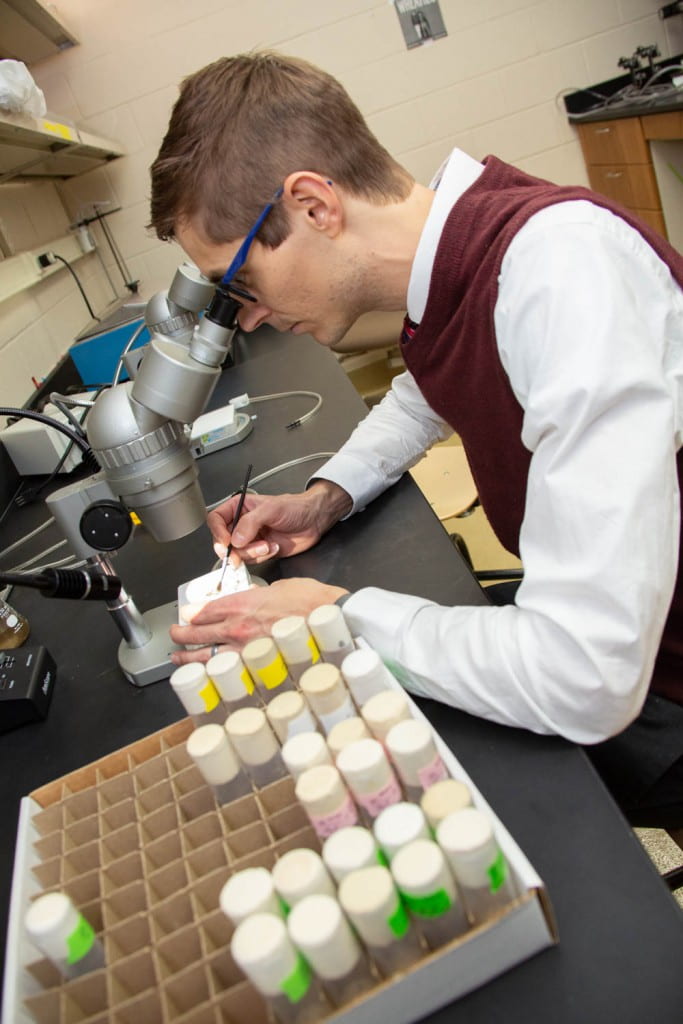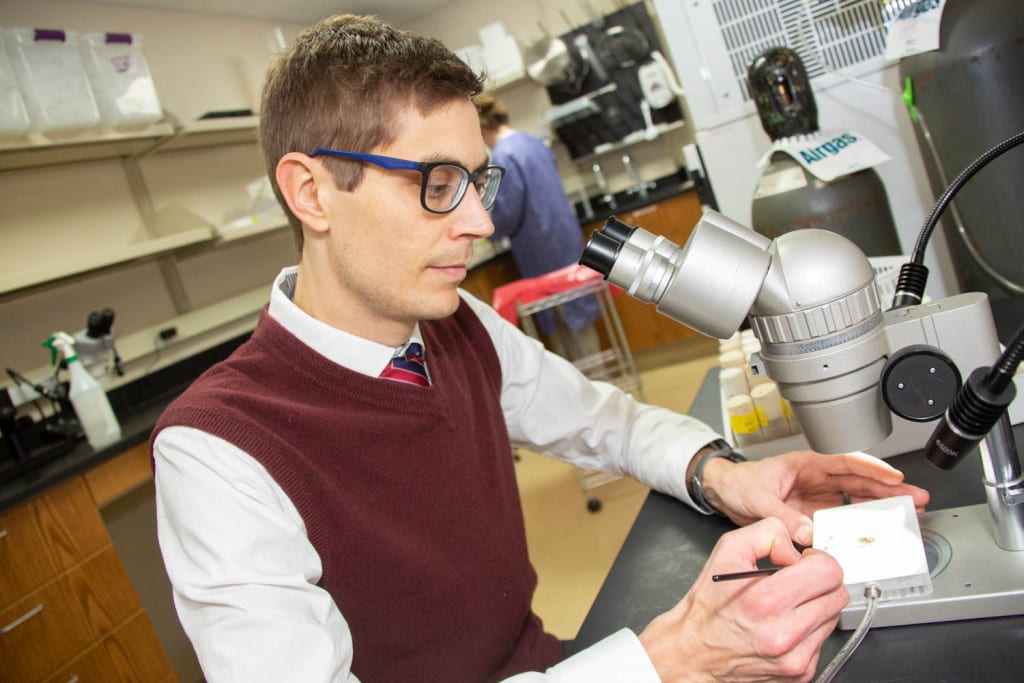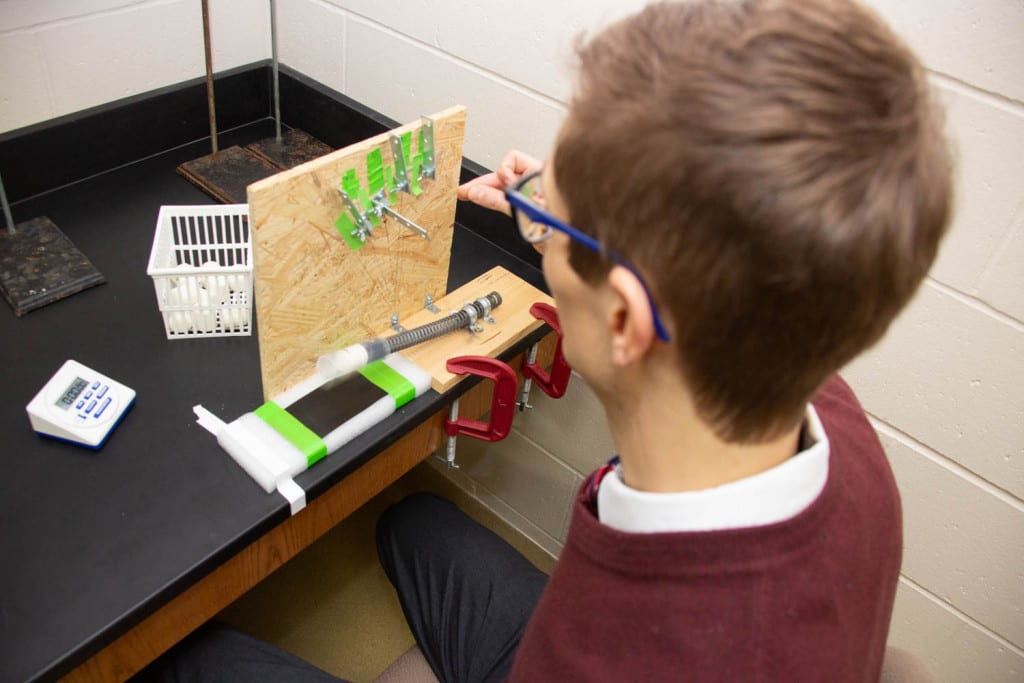Deceptively simple fruit fly may provide life-saving lessons according to UW-Green Bay researchers

The deceptively simple Drosophila melanogaster (fruit fly) may have life-saving lessons to share with the significantly more complex Homo sapiens, lessons that could lead to future changes in treatment of traumatic brain injury (TBI).
 According to a peer-reviewed research paper published recently in the journal Fly[1], results from studies at the University of Wisconsin-Green Bay suggest three significant findings with potential implications for humans:
According to a peer-reviewed research paper published recently in the journal Fly[1], results from studies at the University of Wisconsin-Green Bay suggest three significant findings with potential implications for humans:
- First, repetitive, moderate blows to the head at short intervals have potential for serious injury. There appears to be a cumulative effect from a series of moderate blows within a short time frame, which can be as harmful as a single significant blow.
- Second, the time frame for increased harm caused by repeated injuries can operate at shorter timescales than has been previously appreciated. The research suggests that consideration must be paid to repetitive injuries that occur closely together.
- Finally, TBI caused an initial impairment of motor coordination, temporary recovery, and then a second, delayed impairment before full recovery was achieved. Single severe injuries caused the same impairment as repetitive moderate blows. Thus, if only using coordination measures, there is a risk for improperly determining an individual has recovered from a TBI event, whether severe or moderate, at an early time-point, when in fact they are still in the process of fully recovering.
By now you’re probably asking, “All of this from a fruit fly?”
“That’s a question I get a lot,” smiles Doug Brusich, assistant professor of Human Biology and leader of the research team. “People wonder why we use fruit flies and how results from those studies can have any relevance to humans.”
Brusich recited the reasons with the ease of someone who has answered this question many times before:
“Fruit fly genes mirror human genes very closely,” said Brusich, “so while findings may not be completely analogous, they usually point us to something that might be worthy of further study in mammals, including humans.
“Their genes are also easier to work with than mammal genes,” he continued. “For example, where mammals might have nine genes that govern sodium channels, fruit flies have one. If you make a change in that sodium channel and observe a result, you have a potential indication of a similar importance in mammals.
“Fruit flies also breed quickly, from larvae to adults in 10 days, and have 80-day life cycles,” said Brusich, “so we can develop hundreds of flies for study in a relatively short time. And we can use flies at varying stages of their lives to see if age has any impact on the results.
“We also have to consider the financial and ethical aspects of our research,” he added. “Fruit flies are very inexpensive to maintain in the lab, especially compared to the cost of other potential subject animals like mice. And the ethical questions that arise when inflicting brain damage on flies are much less complex.
“It’s also important that the ways we produce injuries on flies in the lab is as similar to the ways humans experience TBIs,” Brusich concluded, “The results from fruit fly research come from impact and rotational forces that closely resemble forces humans might experience.”
Expanding the research to new levels
Brusich and his team at UW-Green Bay—former undergraduate student Lauren Putnam (2018), and current undergraduates Nathaniel Disher, Brooke Kalata and Ashley Willes—knew the literature contained well documented fruit fly studies of TBI based on single, high-impact strikes. They wondered, though, whether the methods in those studies could be used to study milder injuries, which are more common but less understood.
“There were two reasons we pursued this path,” explained Brusich. “First, mild head trauma is quite common and affects human health. Roughly 70-90% of the greater than 1.5 million annual TBI events resulting in hospital visits in the United States are classified as mild, however, just as many mild injuries are estimated to go unreported. Additionally, we have evidence that mild head injuries which fail to even meet classic criteria for a concussion result in changes in brain health.
“Second,” he continued, “mild injuries have so far been poorly studied or modeled by mammalian or fly models of TBI. This is in part because mild injuries don’t always generate noticeable outcomes. As a result, we have little information about mild TBI.
“Expanding our studies to reduced levels of severity opens the possibility of investigating similarities and/or differences in predisposition and consequences in response to severe versus mild TBI,” he concluded.
Is it dead or just sleeping?
Anyone who has swatted a house fly has seen the immediate effect of a (lucky) strike. The fly is temporarily stunned and may sit motionless for a short time before recovering and flying off to annoy you again.
It turns out the temporary disorientation we casually observe is one of the behaviors researchers look for after striking flies in the lab. They also have other behavioral clues to watch for and record.
But those clues are subtle and you can’t have a lab full of researchers swatting willy-nilly at a room full of flies that are smaller than a house fly’s wing. For one thing, the lab is only the size of a galley kitchen. For another, how would you observe and record any of the fruit flies’ behavior in such an environment? How do you set up a study that provides predictable levels of “swat” energy and enables recording of the results?
Brusich and his team arrived at a MacGyver-like solution by adapting a compression spring-powered device developed by researchers at UW-Madison specifically for fruit fly research. The original device produced a strike (a “swat”) by attaching a vial of 20 to 60 flies to the end of the 10-inch-long coil spring, affixing the spring horizontally to a padded surface, pulling the spring upward to a 90-degree deflection from the table, then releasing the spring to return to its horizontal position, stunning the flies in the vial.
This method has become known as the High-Impact Trauma (HIT) method and has been widely adopted in fly research.
For his team’s purpose, Brusich modified the device so it could reliably and accurately produce single or multiple strikes at 60-, 70-, 80- and 90-degree deflections. This enabled the team to examine the results of repetitive HIT events to about 34,000 fruit flies across varying levels of severity, from mild to severe.
The team also combined low-tech and high-tech solutions to study the fruit flies’ ability to walk (geotaxis) after TBI events. They used a plywood frame and elastic bands to hold several vials upright, then dropped the frame three times from a set height, forcing the flies to the bottom of the vial.
They then used a Logitech webcam to watch as the flies reacted: some scrambled to the top, some remained confused and some stayed at the bottom. Using screen shots and statistical modeling software, the flies’ actions were catalogued, timed and plotted.
The results of the study confirmed other researchers’ findings for severe TBI effects (strikes at 90-degree deflections) and produced the three novel results described above (arising from repetitive strikes at varying intervals that produce less severe, but cumulative, TBI effects).
“We were happy that our study produced results so consistent with what others had found,” said Brusich. “And we think the findings that resulted from expanding the methodology to less severe levels of TBI have potential implications for further study in fruit flies and mammals. Future findings could change the way we assess and treat TBI.”
From TBI to epilepsy and Alzheimer’s disease
Brusich is already taking information from his TBI research into others areas of exploration.
“I initially got into studying epilepsy from experiments I conducted as part of my graduate thesis,” said Brusich. “I started using TBI in part to model post-traumatic epilepsy, which my lab is now studying. More broadly, TBI findings are relevant to aging and neurodegeneration, such as from dementias like Alzheimer’s, and so the more we learn from this model the better. TBI is also a trending topic in research, so the additional perks are that it is garnering more funding and becoming an attractive and enjoyable area of research for prospective students.
“I have long wanted my role to be a split research-teaching one at a primarily undergraduate school like UW-Green Bay,” he continued, “and the simple, low-cost set up of my lab is appropriate for undergraduate involvement. The supportive environment created by my dean and by the school in general has enabled us to carve out this niche for ourselves versus the research functions at some of the larger schools.”
Aspiring researchers welcome
Brusich hopes other students who share his passion for fundamental research will consider joining him.
“I always mention my research interests in the courses I teach and ask students to chat with me if they think they might be interested in research,” said Brusich.
“I compile a list of these students and others who have heard about the opportunity, then invite students from the list to interviews held once or twice a year. Students are always welcome to contact me (email is best) if they are interested in research.”
[1] Lauren J Putnam, Ashley M Willes, Brooke E Kalata, Nathaniel D Disher & Douglas J Brusich (2019): Expansion of a fly TBI model to four levels of injury severity reveals synergistic effects of repetitive injury for moderate injury conditions, Fly, DOI: 10.1080/19336934.2019.1664363.
Story by freelance writer Jim Streed ’05, photos by Dan Moore, UW-Green Bay photographer and videographer






